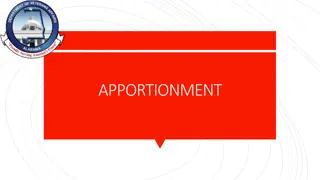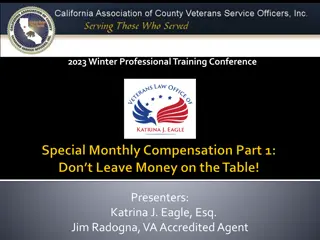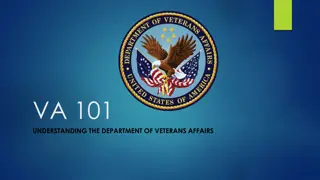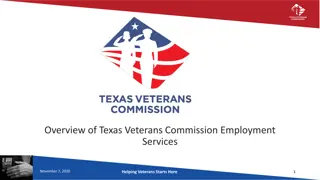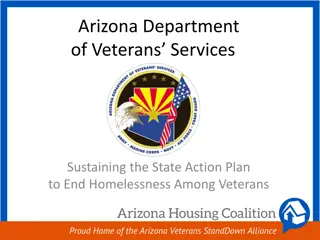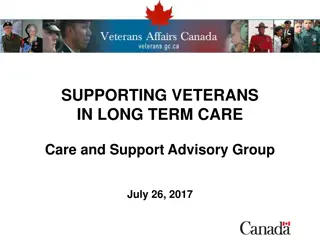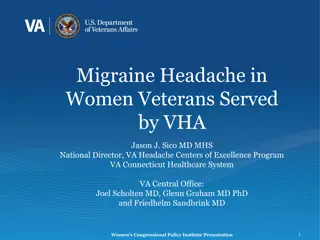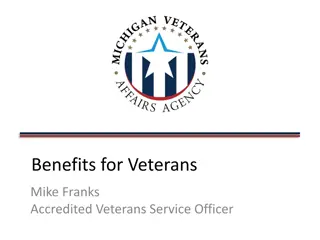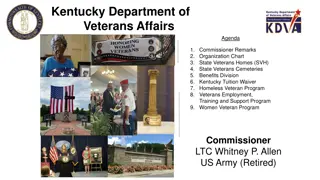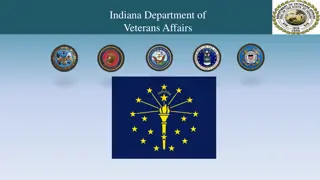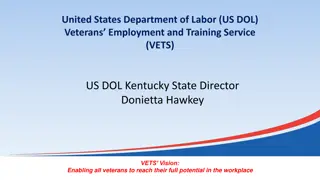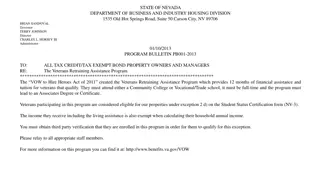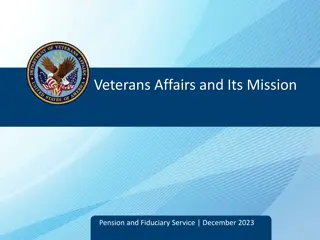Understanding VA Disability Benefits for Veterans with Disabilities
Exploring the various benefits offered by the Department of Veterans Affairs (VA) for veterans with disabilities, including pensions, compensation, healthcare, education, and more. Learn about eligibility criteria, character of discharge evaluation, and pension requirements based on wartime periods.
Download Presentation

Please find below an Image/Link to download the presentation.
The content on the website is provided AS IS for your information and personal use only. It may not be sold, licensed, or shared on other websites without obtaining consent from the author. Download presentation by click this link. If you encounter any issues during the download, it is possible that the publisher has removed the file from their server.
E N D
Presentation Transcript
Introduction to Benefits for Veterans with Disabilities An Introduction to VA Disability Benefits Unruh Law, P.C. 100 Pine Street, Suite 1250 San Francisco, CA 94111 john@jru-law.com John Robert Unruh
What is the Department of Veterans Affairs? Veterans Health Administration (VHA) Veterans Benefits Administration (VBA) National Cemetery Administration
VA Benefits Pension Not service-connected Means tested Compensation Service connected Not means tested Benefits for Dependents (DIC and Survivors Pension) Health Care Education and Training Home Loan Guaranty Life Insurance Burial and Memorial Services
Basic eligibility: Veteran status Federal: Army, Navy, Air Force, Marines, Coast Guard. National Guard only if federalized. Active: Reserve only if mobilized. Honorable service: A person who has served in the active military, naval or air service, and who was discharged under conditions other than dishonorable. (38 USC 101, 38 CFR 3.12(a, d), emphasis added.) No statutory bars: 38 CFR 3.12(b, c) Conscientious objector, general court martial, deserter, AWOL > 180 days unless mitigated
VA Character of Discharge evaluation Discharged or released under conditions other than dishonorable. 38 USC 101(2) Characters of service: Honorable General (under honorable conditions) Other than Honorable or Undesirable Bad Conduct Dishonorable Uncharacterized
Pension: Eligibility Veteran status. Time in service: Prior to 1980: 90 days Since September 1980 At least 24 continuous months, or Completion of time ordered to active duty, or Compensable service-connected disability. Disabled: Permanently disabled for any reason (SSI usually sufficient), or At least 65 years old. Low-income: monthly income under $1,597 (current pension rate as of 12/01/21); assets under ~ $138,489. Income can be offset by some expenses, and some exempt assets. Wartime service: At least one day during a declared wartime period.
Pension Wartime Periods Wartime period Start End World War II December 7, 1941 December 31, 1946 Korean Conflict June 27, 1950 January 31, 1955 Vietnam Era August 5, 1964 May 7, 1975 Vietnam Era if in theater February 8, 1961 May 7, 1975 Persian Gulf War August 2, 1990
Compensation 38 USC 1110, 1131 Compensate reduction in earning capacity caused by military service. Awarded on percentage basis, 0% 100% in 10% increments. Not each disability is ratable at each increment. Monthly payments. Tax free.
Compensation: Eligibility Veteran status. No time in service requirements. Service connection: current disability incurred or aggravated during service. Rating: evaluation of present impairment.
Compensation: Service connection To have a viable claim for service-connected disability compensation you need the following three elements: An in-service event, injury, or diagnosis; plus, a current disease or disability; and a nexus between the two. 1. 2. 3.
Compensation: In-service injury or illness Incurred in or aggravated during military service. As shown by: Lay evidence of event, corroborated by objective evidence. Special standards for events in combat and for PTSD. 38 CFR 3.204 (d, f) Medical evidence of illness during service. Medical evidence of illness during a presumptive period. 38 CFR 3.307, 3.309 Presumption of soundness. Not a result of willful misconduct. 38 CFR 3.301
Compensation: Current disability Current diagnosis Use DSM-V for mental disability Non-compensable: Personality disorders
Compensation: Nexus Causal relationship between in-service injury and present disability. Theories of service connection: Direct Typically requires continuity of treatment. Chronic = permanent. Does not require continuity of treatment. Presumptive No nexus required. 38 CFR 3.307-309 Secondary. Condition is a result of another condition that is already service-connected. May include substance abuse for mental health disabilities. 1151. Disability due to VA malpractice. 39 USC 1151 Competent evidence Must be medical opinion. May use treatise evidence, but not given much weight. Standard At least as likely as not (50% or greater).
Compensation Rates (as of 12/01/22) Compensation Rating Compensation Rating Compensation 10% $165.92 60% $1,319.65 20% $327.00 70% $1,633.06 30% $508.05 80% $1,933.15 40% $731.86 90% $2,172.39 50% $1,041.82 100% $3,621.95
Compensation Rates Criteria Measures functional loss in earning capacity Based on schedule 38 CFR 4.40 et seq. Duration Can be temporary or permanent Combining Ratings Consider it like a discount on a discount. 38 CFR 4.25 No pyramiding. 38 CFR 4.14 Supplements Total Disability for Individual Unemployability (TDIU). If one disability is rated 60%, or multiples add up to 70%, then may increase to 100% if combination of disabilities allows no or marginal employment. 38 CFR 4.16-17, VA Form 21-8940 Special Monthly Compensation.
Benefits for Dependents Dependency and Indemnity Compensation (DIC) Monthly benefit paid to eligible survivors. Service member who died on active duty. Veteran whose death resulted from a service-connected condition. Veteran whose death did not result from a service-connected condition, but who was had been receiving disability compensation and rated totally and disabled for the 10 years immediately before death. Survivors Pension ( Death Pension ) Monthly benefit for low-income surviving spouse and/or unmarried child(ren) of veteran with wartime service. Current rate of $1,437.66 per month (adjusted by certain factors). Please note, this list is not exhaustive.
How to make a claim? Original. (VA Form 21-526EZ for Pension or Compensation) Fully Developed Claim. (VA Form 21-526EZ) Supplemental. Requires new and relevant evidence. CUE Clear and unmistakable error . a legal error in the original decision that determined an unfavorable outcome. May mean benefits are retroactive to the date of original claim.
Overview Claims Process Informal claim no longer allowed Claim must be on proper VA form (VA.gov) Development records requests Compensation and Pension (C&P) Exam Rating Decision Initial claim Appeals Modernization took effect February 2019 Three new ways to handle disagreement (1 year deadline): Higher-Level Review Supplemental Claim Appeal to the Board Regional Office appeal Notice of Disagreement (1 year deadline) Direct Review Evidence Submission Lane Hearing Lane BVA hearing: in person or teleconference Decision, usually with remand. Board for Veterans Appeals (BVA) Court of Appeal for Veterans Claims (CAVC) (120 day deadline) Federal Circuit SCOTUS Judicial review
Representation of Vets: Accreditation and Fees To assist a veteran with a claim for benefits, one must be accredited by the VA. 38 C.F.R. 14.626, et seq. Beware of Pension Poachers. Fees are allowed, but there are certain limitations. A 20% contingency fee is presumed to be reasonable. Fee Agreement must be filed with the VA to have VA withhold 20% payment.
VA Healthcare Each Veteran s medical benefits package is unique. All Veterans receive coverage for most care and services, but only some will qualify for added benefits like dental care. The full list of your covered benefits depends on: Your priority group, and The advice of your VA primary care provider (your main doctor, nurse practitioner, or physician s assistant), and The medical standards for treating any health conditions you may have https://www.va.gov/health-care/about-va-health-benefits/ (Current as of 09/19/23)
VA Housing Assistance Disability Housing Grants for Veterans Specially Adapted Housing Grants Housing for Homeless Veterans HUD-VASH (U.S. Department of Housing and Urban Development-VA Supportive Housing Program Veterans Mortgage Life Insurance https://www.va.gov/housing-assistance/ (Current as of 09/19/23)
EDUCATION Education Benefits Vary depending on time in service (e.g., GI Bill, Post-9/11 GI Bill). Dependents Educational Assistance for dependents. Veteran Readiness and Employment (VR&E) Retraining/rehabilitation services. On-the-job training and apprenticeships.
MISCELLANEOUS BENEFITS Clothing allowances Aid and Attendance Caregiver Program Traumatic Injury Protection Under Servicemembers Group Life Insurance Family Servicemembers Group Life Insurance Veterans Group Life Insurance Servicemembers Group Life Insurance
BURIAL BENEFITS You may be eligible for Veterans burial allowances if you re paying for the burial and funeral costs and you won t be reimbursed by any other organization, like another government agency or the Veteran s employer. You must also meet additional requirements found on VA s website: https://www.va.gov/burials-memorials/veterans-burial- allowance/ (Current as of 09/19/23)
TYPES of BURIAL BENEFITS VA burial allowance for burial and funeral costs VA plot or interment allowance for the cost of the plot (gravesite) or interment VA transportation reimbursement for the cost of transporting the Veteran s remains to the final resting place. Burial flags and Memorial Markers/Headstones There is a time limit for filing for a non-service-connected burial allowance within 2 years after the Veteran s burial or cremation.
BURIAL in a VA NATIONAL CEMETERY Veterans, service members, spouses, and dependents may be eligible for burial in a VA national cemetery, as well as other benefits, if they meet one of these requirements. One of these must be true: The person qualifying for burial benefits is a Veteran who didn t receive a dishonorable discharge, or The person qualifying for burial benefits is a service member who died while on active duty, active duty for training, or inactive duty for training, or The person qualifying for burial benefits is the spouse or minor child of a Veteran, even if the Veteran died first, or The person qualifying for burial benefits is in some cases, the unmarried adult dependent child of a Veteran



